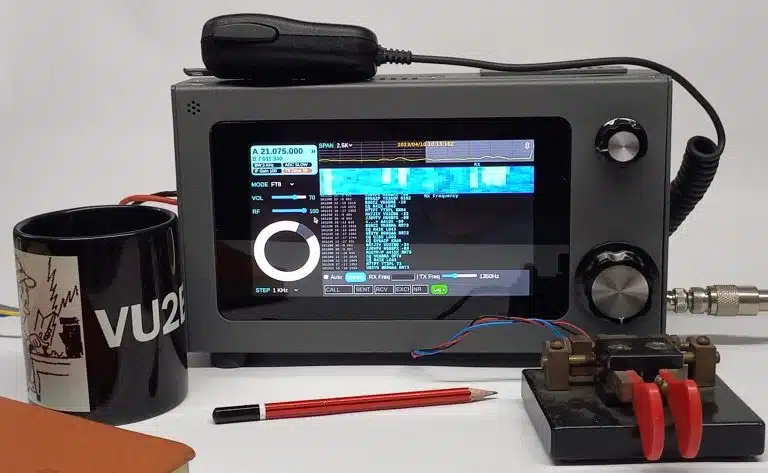
Last year, India’s favourite homebrewer came up with a hybrid SDR transciever – sBITX. sBitx as an experimentor’s transceiver, draw mixed reviews from the amateur radio hobbists. Well, that’s how the homebrew projects mostly work, isn’t it? This was all about version 1.
The UI is definately overall from the previous boring and sometimes confusing GTK based user interface of the version 1. Interstingly v2 interface is designed with web technologies i.e. HTML, CSS & JS. This makes making UI changes easier for everyone.
- The big compact : Although compact, it has the largest display shipped with a transceiver, a capacitive, touch screen of 7 inch.
- All software to run modes like FT8, RTTY, PSK31 is integrated into the radio, without any messy configurations, setup, etc. to deal with.
- It switches soundlessly from transmit to receive and between bands due to its electronic of filters and T/R,
- Band-stacking VFOs with 4 memories on each of the 8 bands, 9 convolution digital filters for the best audio experience.
- High performance electronics with a passive-FET front end, 7 crystals’ filter and a low phase noise, temperature compensated crystal oscillator.
- The built-in, editable macros that make it a breeze to work DX or compete in contests.
- Add an HDMI monitor or use the browser from your PC/tablet to have a large screen experience of all the features of this amazing radio.
- In-built FT8 that works out of the box.
- One touch operation. Touch to call CQ or start the contact
- Automatically logs all the QSOs into the built-in logbook
- In-built, high accuracy, real-tme clock
- Totally noiseless, fast electronic T/R without noisy relays
- In-built N1MM style Macros support Running and S&P
- Uses Fldigi with its high performance decoder in the background
- Raised cosine cw keying with perfect shaping
- 9 Ring-free Convolution filters from 3 KHz to 100 Hz
- Use the onscreen touch keyboard or add a USB/wireless keyboard for effortless CW sending
- Convolution SDR technology and a 7 element crystal filter to provide superbSound quality with punchy clarity.
- Built-in microphone and touch screen PTT as an alternative to plugging in a mic
- It works with any other mic (standard audio jack)
- Transmit IMD of 30 db
- Receiver with variable receiver bandwidth from 3KHz to 1.8 Khz
- Built-in two tone generator to align external linear amplifier or tune your antenna
- The sbitx has a logger and logbook with RDMS support.
- N1MM style logger with macros and automatic logging of contacts with the frequency, mode, time automatically filled in.
- Use macros on CW/RTTY/PSK to send out standard messages with the press of a button/key.
- See the spots, dx clusters on the radio with in-built telnet to DX Clusters, Reverse Beacon, PSK Reporter, etc.
- Full source code, circuit and explanations on github.com/afarhan/sbitx
- Write custom apps in javascript without learning SDR coding
- Open source, hackable SDR written in C
- Develop your own skins and UI in HTML/CSS/Javascript
- With your sbitx connected to the home wifi, just open http://sbitx.local on the browser of your phone/tab/pc and start operating your radio! With the bigger screen of your PC or tablet, you can have an expanded user interface of the sbitx.
- The sBitx project is committed to providing eye-free usage for the sbitx. As a first step, this release features a command line interface that provides all the features of the GUI.
| Frequency | Receive; 500 KHz to 30 MHz, Transmit: 3500-4000, 7000-7300,10000-10150, 14000-14350, 18000-18200, 21000-21450, 24800-25000, 28000-29700 (KHz) |
| Power Output | 40 watts on 80M – 20M, 30 watts higher bands |
| Power Consumption | Receive: 600 mA Transmit : 9A |
| VFOs | Two VFOs A and B, with split operation, tunable in steps of 100 KHz, 10 KHz, 1 KHz, 100Hz and 10 Hz. Direct frequency entry from the keyboardRIT : Receiver incremental tuning +/- 25 KHz Split operation: Cross band |
| Band stacking | 4 frequencies/modes on each band, selectable by repeatedly pressing the band switch. |
| Modes | USB, LSB, CW, CW-Reverse, RTTY(45), PSK31, FT8 (with on-display decoding and sending) 2-Tone test signal for intermodulation testing and PEP measurements. |
| Logging | Built-in logger with N1MM format macros, Auto incremental Exchange number of contesting. |
| Recording | Record your QSOs int WAV format files |
| Third party apps | Fldigi: FLdigi intergrated via xml-rpc. QRZ.com: Queries your contact’s callsign on qrz.com |
| Receiver | Noise Figure: +15 dB, IIP3 : +28 dBm |
| Transmitter | Upto 40 watts of variable output power Better than -43 dBc suppression of spurious signals Speech compression on SSB |
| Telnet | Connects to RBN and DX clusters from the radio |
The sBitx-v2 measures 10″x 6″ x 2″ and weights about 4 pounds (2Kgs)
Where to Buy: https://www.hfsignals.com/index.php/sbitx-v2/
You can follow sBitx developement here: https://groups.io/g/BITX20
Here’s the video from Farhan showing sBitx v2 with various features – filters, bandstacking, logging and audio recording etc while making a quick contact over India’s oldest HF Net @ 7050 – 40 Meters (Belgaum Net)
The fully assembled and tested sBitx-v2. This includes:
- Fully assembled and tested sBitx-v2 with Raspberry 4, 2 GB RAM
- 7 inch capacitive touch display
- 32 GB SD card installed with software
- XT60 power connector with wires soldered
- Microphone

